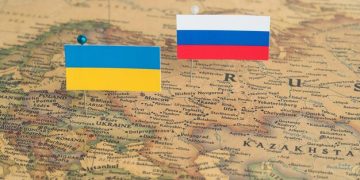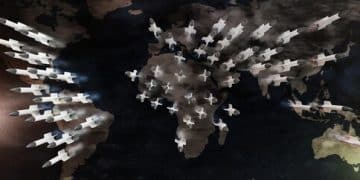US Role in Ukraine Conflict: Is More Military Aid the Answer?

The question of whether increased US military aid is the definitive answer to the Ukraine conflict involves a multifaceted analysis of geopolitical stability, economic implications, and ethical considerations for both involved nations and the global community.
The protracted conflict in Ukraine continues to dominate global headlines, with discussions surrounding The US’s Role in the Ukraine Conflict: Is Increased Military Aid the Answer? becoming increasingly critical. This complex issue involves not just military strategy, but also geopolitical ramifications, economic pressures, and humanitarian concerns that demand careful consideration from policymakers and citizens alike. Unpacking the layers of this debate is crucial to understanding the potential paths forward.
The Geopolitical Landscape and US Interests
The conflict in Ukraine is not merely a regional dispute; it is a pivotal moment in global geopolitics, reshaping alliances and challenging the international order established post-Cold War. The United States, as a leading global power, has significant strategic interests tied to the outcome, influencing not only European security but also perceptions of deterrence and sovereignty worldwide. Understanding these wider implications is essential before evaluating the effectiveness of military aid.
Shifting Balances of Power
The confrontation has irrevocably altered the geopolitical landscape, pushing NATO toward greater unity and prompting non-aligned nations to reconsider their positions. For the US, maintaining a stable, rules-based international order is paramount, and the aggression in Ukraine directly threatens this principle. The response, therefore, is seen as a test of resolve and leadership against attempts to redraw borders by force.
- Reinforcement of NATO’s eastern flank.
- Increased defense spending across European allies.
- Reassessment of energy dependencies on Russia.
- Strengthening of transatlantic alliances.
Beyond immediate security concerns, US economic interests are also intertwined with European stability. Disruptions to trade routes, supply chains, and energy markets have global repercussions, impacting American consumers and businesses. The broader message sent by allowing territorial aggression to go unchallenged could embolden other revisionist powers, leading to a more unstable international environment detrimental to US prosperity and security.
Assessing the Impact of Current Military Aid
Since the invasion, the United States has provided substantial military assistance to Ukraine, ranging from advanced weaponry and ammunition to training and intelligence support. This aid has been instrumental in enabling Ukraine to defend its territory, repel offensives, and even regain significant ground. However, critically evaluating the impact of this assistance goes beyond mere enumeration of equipment; it requires an assessment of its effectiveness on the battlefield, its logistical challenges, and its strategic consequences.
Effectiveness on the Battlefield
The infusion of advanced Western weaponry, such as HIMARS, Patriot missile systems, and M777 howitzers, has undeniably enhanced Ukraine’s defensive capabilities. These systems have allowed Ukrainian forces to target Russian logistics, command centers, and air defenses with greater precision, disrupting their operational tempo. The training provided by US and NATO allies has also improved Ukrainian tactical proficiency, translating into more effective combat operations.
Ukrainian forces have demonstrated remarkable adaptability in integrating diverse weapon systems into their strategy. The success of counteroffensives in regions like Kharkiv and Kherson has been partly attributed to the coordinated use of Western-supplied artillery and intelligence. This highlights not just the quality of the equipment but also the skill and resolve of Ukrainian military personnel.

The logistical challenges of transferring, storing, and maintaining this aid in a war zone are immense. From transatlantic shipping to onward distribution within Ukraine, the process requires constant coordination and adaptation to evolving battlefield conditions. Furthermore, integrating new systems into existing military structures, training personnel, and ensuring a steady supply of spare parts and ammunition are ongoing tasks that stretch resources.
Arguments for Increased Military Aid
Proponents of increased military aid to Ukraine articulate a range of compelling reasons, primarily centered on geopolitical stability, humanitarian imperative, and moral obligation. Their arguments often emphasize that continued and expanded support is not merely assisting Ukraine but is a critical investment in global security and the deterrence of future aggression.
Deterring Aggression and Maintaining International Norms
Central to the argument for more aid is the belief that a strong, united front against unprovoked aggression is essential to preserving the international rules-based order. Failure to adequately support Ukraine could send a dangerous message to other potential aggressors, suggesting that territorial conquest through force can be tolerated. Increased military assistance reinforces Western resolve and upholds the principle of national sovereignty.
- Prevention of wider conflicts in Europe.
- Upholding international law and treaties.
- Demonstrating commitment to democratic values.
- Strengthening collective security frameworks.
Moreover, advocates argue that the cost of inaction or insufficient aid would ultimately be far greater. A prolonged, stalemated conflict or, worse, a Russian victory, could destabilize Eastern Europe, create massive refugee flows, and lead to years of economic disruption. Providing robust military support now is seen as a more cost-effective way to achieve a swifter, more favorable resolution and prevent broader consequences. This also reflects a humanitarian concern for the Ukrainian people, who face daily bombardment and suffering.
Many also point to the moral imperative to assist a sovereign nation defending itself against an invasion. They argue that the US, as a champion of democracy and human rights, has a responsibility to provide the necessary tools for Ukraine to protect its citizens and its freedom. This goes beyond strategic considerations, tapping into a deeper sense of ethical duty on the global stage.
Concerns and Criticisms Regarding Enhanced Aid
While the case for continued military aid to Ukraine is strong, significant concerns and criticisms surround the prospect of increasing such assistance. These reservations stem from a variety of angles, including the potential for escalation, the economic burden on the US, and questions about the long-term effectiveness and strategic objectives of such involvement.
Risk of Escalation and Direct Conflict
One of the primary anxieties is that a continuous increase in military aid, particularly of more advanced or offensive weaponry, could be perceived by Russia as a direct challenge, leading to an escalation of the conflict. This includes the possibility of Russia targeting supply lines outside Ukraine, or even considering the use of non-conventional weapons. The delicate balance between enabling Ukraine’s defense and avoiding a direct confrontation between NATO and Russia is a constant tightrope walk.
Opponents also point to the immense financial cost of increased aid. Billions of dollars have already been allocated, and further commitments would add to the national debt or divert funds from domestic priorities. There are questions about the sustainability of such spending, especially given economic pressures and other global challenges facing the United States.
Furthermore, critics argue that military aid alone cannot resolve the conflict and might even prolong it without a clear diplomatic off-ramp. They suggest that a greater emphasis should be placed on diplomatic efforts, negotiation, and mediation to achieve a lasting peace. Some also express concern about accountability for the weapons supplied, worrying about potential leakage to black markets or unintended use in other conflicts. The long-term strategic goals of continuous military involvement and the definition of a “successful” outcome also remain subjects of vigorous debate.
The Economic Implications for the US
The substantial military aid provided to Ukraine has profound economic implications for the United States, influencing everything from the national budget and defense industry to inflation and international economic relations. Analyzing this impact requires a look at both the direct costs and the ripple effects throughout the economy.
Budgetary Strain and Domestic Priorities
Providing advanced weaponry, training, and logistical support comes at a significant cost, drawing billions of dollars from the US treasury. While much of this aid is tied to existing defense contracts and replenishes US stockpiles, the sheer volume of resources diverted raises questions about domestic spending priorities. Funds spent on foreign military assistance are funds that cannot be allocated to infrastructure, healthcare, education, or other pressing internal needs.
The defense industry, conversely, sees a boost in production and sales, leading to job creation and economic activity in specific sectors. However, this also means increased reliance on defense contractors and potential for price hikes. The urgency of the situation has driven rapid procurement, sometimes at a premium.
Beyond direct spending, the conflict in Ukraine has indirectly contributed to global economic instability, which invariably affects the US. Energy price fluctuations, disruptions to global supply chains, and rising inflation are all consequences that impact American consumers and businesses. While not solely attributable to military aid, the overall engagement in the conflict contributes to these broader economic challenges. Balancing geopolitical imperatives with domestic economic realities remains a critical policy debate.
Alternative Approaches and Diplomatic Solutions
While military aid has been a cornerstone of the US response to the Ukraine conflict, it is not the only avenue for engagement. A comprehensive strategy often includes, and sometimes prioritizes, diplomatic initiatives, economic sanctions, and humanitarian support. Exploring alternative or complementary approaches is crucial for fostering a sustainable resolution and minimizing further suffering.
Strengthening Diplomatic Channels
Intensified diplomatic efforts are seen by many as essential to finding a peaceful resolution. This could involve direct negotiations between the warring parties, mediated by neutral third countries, or multilateral discussions through international bodies like the United Nations. Diplomacy aims to identify common ground, de-escalate tensions, and negotiate ceasefires or peace agreements that address core security concerns of all parties.
- Multilateral peace conferences.
- Bilateral negotiations with clear terms.
- Engagement with non-Western powers for mediation.
- Establishing demilitarized zones and humanitarian corridors.
Economic sanctions, while a form of pressure rather than direct aid, serve as a non-military tool to influence state behavior. The extensive sanctions imposed on Russia by the US and its allies aim to cripple its economy, thereby reducing its capacity to sustain the war. However, sanctions can have unintended consequences, affecting global markets and potentially spurring economic alliances outside the Western sphere.
Long-term humanitarian and reconstruction aid is another vital component. Even as fighting continues, planning for post-conflict recovery is essential. This includes providing immediate relief to affected populations, supporting displaced persons, and eventually rebuilding infrastructure and communities. Such aid not only addresses immediate needs but also helps lay the groundwork for future stability and reconciliation, independent of military actions.
The Long-Term Vision for US Engagement
Looking beyond the immediate needs of the conflict, the United States must articulate a clear and sustainable long-term vision for its engagement in Ukraine and Eastern Europe. This vision should encompass not just military assistance but also broader strategic goals related to regional security, economic stability, and the promotion of democratic values.
Building Lasting Security Architectures
A crucial element of the long-term vision is to establish robust security architectures that can deter future aggression and ensure enduring peace. This might involve strengthening NATO’s collective defense capabilities, supporting Ukraine’s integration into Western institutions, and fostering regional security cooperation among Eastern European nations. The goal is to build a security framework resilient enough to withstand future geopolitical shocks.

Economically, the US could play a pivotal role in Ukraine’s post-war reconstruction and economic recovery. This would involve significant investment, technical assistance, and support for reforms aimed at strengthening rule of law, combating corruption, and integrating Ukraine into the global economy. A prosperous, democratic Ukraine is seen as a key bulwark against Russian influence.
Furthermore, the long-term vision must also address the diplomatic and political dimensions. This includes continuing to support international legal processes for accountability, advocating for human rights, and engaging in multilateral dialogues to address underlying regional tensions. The US’s role is not just about providing military equipment but about being a steadfast partner in building a future where democratic self-determination and sovereign integrity are respected across the globe. This holistic approach ensures that military aid is part of a larger, more impactful strategy.
| Key Aspect | Brief Description |
|---|---|
| 🌍 Geopolitical Impact | US aid strengthens international norms, deters aggression, & reshapes global alliances, crucial for stability. |
| 🛡️ Aid Effectiveness | Advanced weaponry and training have significantly bolstered Ukraine’s defense, allowing territorial gains. |
| 💸 Economic Strain | Billions in aid impact US budget, defense industry, & indirectly contribute to global economic instability. |
| 🤝 Diplomatic Avenues | Beyond military support, diplomatic efforts and sanctions are vital for a lasting, peaceful resolution. |
Frequently Asked Questions about US Military Aid to Ukraine
The US provides military aid to Ukraine primarily to support its sovereignty and territorial integrity against aggression. This is also viewed as crucial for upholding international law, deterring further expansionist actions, and maintaining global stability, aligning with broader US foreign policy interests.
US military aid to Ukraine encompasses a wide range of equipment and support. This includes advanced weapon systems like HIMARS and Patriot missiles, artillery, ammunition, anti-tank missiles, drones, protective gear, and intelligence sharing, alongside crucial military training for Ukrainian forces.
Proponents argue that increased aid is essential for Ukraine’s defense, enables successful counter-offensives, and prevents further Russian territorial gains. It reinforces the international norm against aggression, demonstrates US commitment to allies, and ultimately aims to expedite a conclusion to the conflict.
Concerns include the risk of escalating the conflict with Russia, potentially leading to direct confrontation. There are also worries about the economic burden on US taxpayers, the sustainability of long-term commitments, and questions regarding accountability for the distributed weaponry and its long-term impact on regional stability.
Yes, alternative or parallel approaches include intensified diplomatic efforts to broker a peace agreement, robust economic sanctions to pressure the aggressor, and significant humanitarian aid to support affected populations. A holistic strategy often combines military, diplomatic, and economic measures for a sustainable resolution.
Conclusion
The debate surrounding increased US military aid to Ukraine encapsulates a complex web of ethical dilemmas, strategic imperatives, and economic calculations. While military assistance has demonstrably bolstered Ukraine’s defense and allowed it to reclaim territory, concerns about escalation, financial strain, and the pursuit of diplomatic solutions remain salient. Ultimately, the unwavering commitment of the United States to Ukraine’s sovereignty is not merely a philanthropic gesture but a strategic investment in global stability, requiring a balanced approach that integrates military prowess with robust diplomacy and a clear long-term vision for peace and international order.





